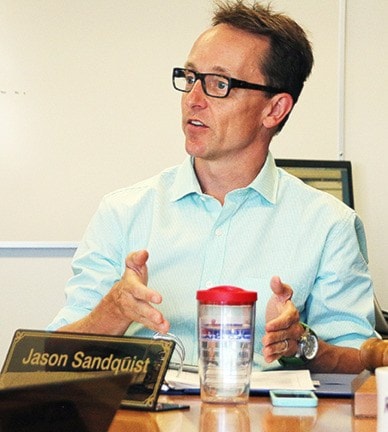Cowichan Valley school trustees axed busing fees for in-catchment riders Aug. 11 in order to scoop up $283,524 in government handouts.
The Ministry of Education announced Aug. 10 that it was offering school districts extra funding under what it called a Supplemental Transportation Allowance. All districts had to do to earn their piece of that big $14.7 million pie was follow the rules and submit a plan on how they planned to spend their money.
However, there was a bit more to it for districts, like Cowichan Valley, that were charging busing fees for students who needed a ride to the school in their catchment area. Fees have been charged in Central Okanagan, Chilliwack, Langley, Maple Ridge, Peace River North, Sooke, and Saanich school districts as well.
District secretary-treasurer Jason Sandquist explained it to trustees at the hastily called board meeting by saying, “after discussions with the Ministry of Education it is understood that the intent of the grant is to provide our district with funding that will offset the fees currently being charged to in-catchment or otherwise eligible riders.”
However, in the Cowichan Valley School District, busing fees will still be charged for out-of-catchment riders, international students or students in programs of choice like French Immersion.
At some point soon, upon approval of the plan by the ministry, the board will need to update its policy book, removing in-catchment riders from the fee schedule shown there.
The district’s transportation services are subject to review this fall anyway, following the spring’s budget talks, and recommendations for the 2017/18 budget are expected to be made.
Sandquist reassured trustees that the district’s allocation of $283,524 “will provide sufficient funding to offset the fees that would have been collected for in-catchment riders for the 2016/17 school year.”
However, the district must return to parents any money that’s been paid.
“We have collected a great deal of those fees already this year. Which would mean, once this grant is approved, we would be returning those fees to those parents who have paid us. A lot of work was done in June to get ahead of the collection in September,” Sandquist said.
He estimated that “about two-thirds” of school bus riders are in-catchment.
He said the grant is almost equal to the money the district would lose in fees.
“The ministry did a lot of checking before the grant was announced to determine if districts would be in a hardship position. It’s very, very close [in the Cowichan Valley],” he said.
Trustee Cathy Schmidt asked if walk limits factor into the busing changes but Sandquist said, “If they’re in their in-catchment school and we are currently transporting them they should be outside of the walk limit.”
Trustee Rob Hutchins wanted to know where districts that weren’t charging for busing would get to spend their grant money.
It will still need to be used to “enhance the services they already have,” Sandquist told him.
“To be eligible to receive those monies, they would have to convince the ministry that they are going to use those funds in a way that is going to provide more service than is currently there,” he said.
Hutchins wanted it clearer than that and also asked if this was the first time the province has provided operational funds for transportation.
Transportation funding has been dealt with several ways, Sandquist said.
“It used to be part of the funding formula. You used to receive exactly what you spent the year before. So there was an incentive for districts to continue to grow their transportation departments.
“Then, [the province] didn’t know how to deal with that within the funding formula, so for about a decade, it remained capped and frozen as a funding line. Then it was eliminated altogether about five years ago and put into what is now called ‘the student location factor’. So, based on your students’ distance from their schools, there’s a formula that we get funded on.
“This is a top up to that formula. The political catalyst of this grant was to eliminate in-catchment busing fees. We are not adding extra service with the funds, we will take the load off the parents,” he said.
Schmidt asked about districts that don’t offer busing at all and board chair Candace Spilsbury said they were “primarily in the Lower Mainland where there is lots of transit.”
Trustee Barb De Groot asked it this would be a one-time grant and Spilsbury replied that Education Minister Mike Bernier had phoned her “to make sure we had a heads’ up on this opportunity. One of the questions I had was that very thing. He assured me that it was ongoing and that it would continue through the block funding from now on.”
Spilsbury said, “This seems like a wonderful opportunity to support our students and families” but wanted to know if there were any potential downsides to it.
Sandquist said the only thing he could foresee is possibly some pressures on some bus routes as riders sign up who would only be using the bus once in a while.
Trustee Elizabeth Croft said she thought it was “wonderful” that parents could look forward to seeing this money back in their pockets.
“It would be nice if we were able to transport our out-of-catchment and our French immersion students [free] as well. But practically, it’s probably not doable right now,” she said.
